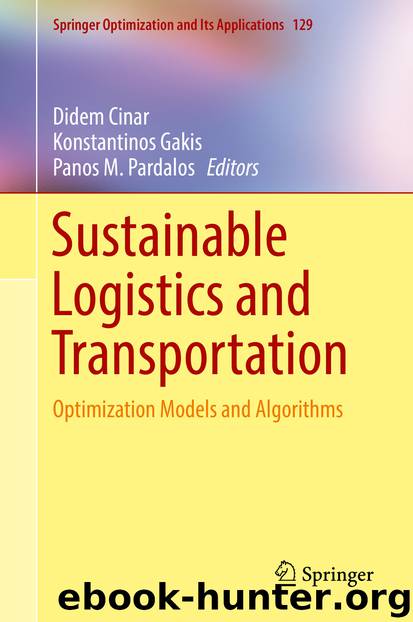Sustainable Logistics and Transportation by Didem Cinar Konstantinos Gakis & Panos M. Pardalos

Author:Didem Cinar, Konstantinos Gakis & Panos M. Pardalos
Language: eng
Format: epub
Publisher: Springer International Publishing, Cham
1.3 Sustainable Logistics Network Design
Globalization of logistics networks has increased transportation distances which in turn has led to intensification of air and pollution, resource consumption, land use, and acidification which can affect the human health and ecosystem quality [47]. For instance, in the USA, from 1995 to 2006, the total amount of emissions by trucks increased about 7% [77]. Furthermore, governments have passed rules to support environment, such as greenhouse gas reduction regulation in European Union, Australia, and Canada. In addition, they have considered targets to decrease emission and force companies to switch over to green logistics and measure and control their carbon footprints [64].
Organizing and designing of logistics networks based on sustainable development paradigms can play fundamental role in moving toward sustainability. Network design is the initial point to start when looking for sustainable supply chain network [55]. Logistics network design (LND) is the most important strategic decision in the supply chain management. LND problem includes the determination of the number, location, capacity, and technology of the required network facilities and the quantities of aggregate flow between them to meet the demand nodes [30]. In the traditional view, the LND problem only focuses on long-term economic performance without paying attention to the environmental and social issues. However, the necessity of sustainability creates a need for considering Env and Sol objectives in the LND problem.
The remainder of this book chapter is organized as follows. In the next section, the relevant literature is reviewed. In Section 3, a comprehensive description is given on environmental and social impact assessment methods. Two selected mathematical programming models for sustainable logistics network design problem under uncertain data are presented in Section 4. The studied case and its acquired results are described in Section 5. Finally, some future research directions are presented in Section 6.
Download
This site does not store any files on its server. We only index and link to content provided by other sites. Please contact the content providers to delete copyright contents if any and email us, we'll remove relevant links or contents immediately.
Modelling of Convective Heat and Mass Transfer in Rotating Flows by Igor V. Shevchuk(6216)
Weapons of Math Destruction by Cathy O'Neil(5805)
Factfulness: Ten Reasons We're Wrong About the World – and Why Things Are Better Than You Think by Hans Rosling(4477)
Descartes' Error by Antonio Damasio(3154)
A Mind For Numbers: How to Excel at Math and Science (Even If You Flunked Algebra) by Barbara Oakley(3097)
Factfulness_Ten Reasons We're Wrong About the World_and Why Things Are Better Than You Think by Hans Rosling(3038)
TCP IP by Todd Lammle(3002)
Applied Predictive Modeling by Max Kuhn & Kjell Johnson(2896)
Fooled by Randomness: The Hidden Role of Chance in Life and in the Markets by Nassim Nicholas Taleb(2849)
The Tyranny of Metrics by Jerry Z. Muller(2831)
The Book of Numbers by Peter Bentley(2766)
The Great Unknown by Marcus du Sautoy(2526)
Once Upon an Algorithm by Martin Erwig(2469)
Easy Algebra Step-by-Step by Sandra Luna McCune(2456)
Lady Luck by Kristen Ashley(2397)
Practical Guide To Principal Component Methods in R (Multivariate Analysis Book 2) by Alboukadel Kassambara(2371)
Police Exams Prep 2018-2019 by Kaplan Test Prep(2346)
All Things Reconsidered by Bill Thompson III(2254)
Linear Time-Invariant Systems, Behaviors and Modules by Ulrich Oberst & Martin Scheicher & Ingrid Scheicher(2224)
